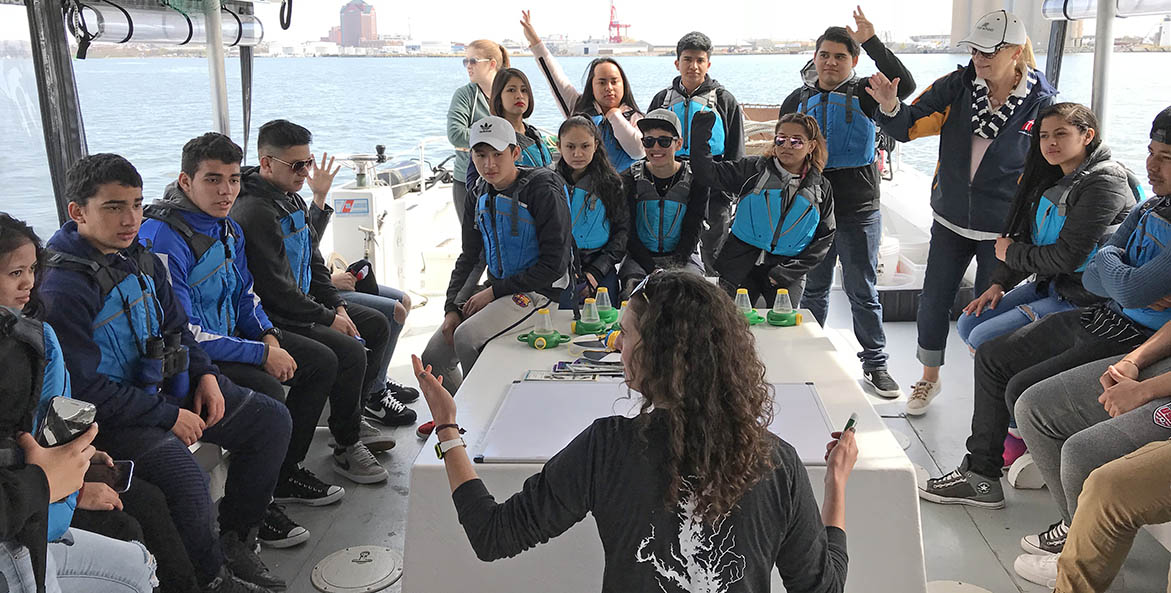My career as an educator with CBF began in 2007, more than a decade ago, on the Potomac River in Washington, D.C. On the river, we could sometimes find clumps of detached underwater grasses to haul aboard the boat and inspect for species diversity and macroinvertebrates, but the grassbeds themselves were elusive. Now, at low tide, the tops of grasses break the surface of the river the entire length of the runway at adjacent Reagan National Airport. Students see the grasses, the grassbeds, and the improving water that allows them to grow. This is one of the most noticeable improvements in Bay health we have observed in the past decade.
This past decade also marked the birth of the Chesapeake Clean Water Blueprint, established in 2010. Because of the Blueprint, over the past ten years all across the watershed, cities have upgraded their sewage treatment plants, farmers have implemented best management practices, towns have found restorative ways to manage polluted runoff. And students have seen this progress first-hand by measuring the improving water quality.
But, also in this time, we have begun to see more prominently the effects of climate change.
In 2007, teachers rarely asked me to include climate change in the issues we addressed during field experiences with their students. Today I manage the Baltimore Harbor Environmental Education Program, and students and teachers ask every day how climate change impacts the Bay. In fact, two years ago students helped us identify an algae bloom in Baltimore Harbor in early December—once a rare occurrence now observed every year likely because of rising water temperatures. Last year, CBF’s State of the Bay grade dropped a point because of record-breaking rainfall in 2018. No, we cannot control the weather, but we do know that a changing climate is causing more extreme weather in the Chesapeake Bay watershed.
Here’s the good news: We know that the Blueprint is working, and the Bay is becoming more resilient to disturbance. Despite that massive assault from record rainfall in 2018 and persistent wet weather in 2019, underwater grasses remained resilient. The blue crab population rose significantly by 60 percent last year, and buffers of native trees are taking root and reducing pollution in the heart of Pennsylvania farm country. In addition, we know that practices put in place to meet Blueprint commitments (regenerative agriculture, restoring forests, planting trees, using vegetation to manage stormwater) aid in sequestering carbon from the atmosphere. We know that what is helping the Bay get better is also addressing the climate crisis.
This is my paradox—helping students and teachers experience, investigate, and explore the Chesapeake is fun, fulfilling, and joyful work but to constantly deliver bad news is just the opposite. And this news can be overwhelming for young people. Yes, Chesapeake islands are disappearing. Yes, the administration is rolling back fundamental environmental protections that protect our air and water. Yes, you can get sick from eating too much fish from Baltimore Harbor. Yes, our Bay is suffering from the actions (or inactions) of previous generations.
BUT this is what keeps me going: We have not only figured out what the problems are, but we know how to solve them. In addition, students are asking the right questions and challenging adults to be held accountable. We will no doubt experience more setbacks in the decade to come, but if we can keep on the path of progress established in the last decade, continue to learn and find innovative solutions, we will be closer to a healthy, restored Bay and more resilient in the face of climate change. This is how I remain hopeful in this new year and new decade.
—Claire Cambardella, CBF's Baltimore Harbor Environmental Education Program Manager



